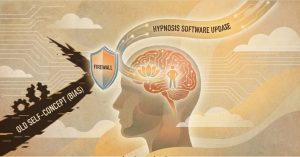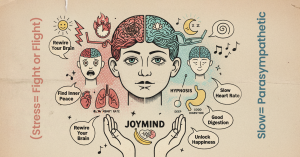Have you spent months—even years—in talk therapy, gaining insight but still feeling stuck? You’re not alone. Many people reach a point where talking about the problem just isn’t enough. Insight isn’t translating into change. That’s because talk therapy, for all its strengths, often misses the deeper terrain of the unconscious—where true transformation begins (Glock, 2024a).
At Joymind, we take a radically different approach. We work in the realm of metaphor, story, and trance states—the very language of your unconscious mind. Through Dr. Michael Glock’s 3-step metaphor-laden hypnotherapy, clients move from endless talk to deep change.
1. Why Talk Therapy Sometimes Isn’t Enough
Talk therapy typically focuses on conscious analysis: identifying cognitive distortions, revisiting past experiences, and exploring feelings through dialogue. While it can be validating and enlightening, it often falls short when:
-
The problem is rooted in unconscious belief systems that don’t respond to logic.
-
Clients understand the issue intellectually, but still feel emotionally stuck.
-
Resistance arises, especially when clients feel pushed to adopt new ways of thinking too quickly.
Despite the best intentions, clients may walk away week after week with more awareness—but no real change. That’s because conscious awareness is not the same as unconscious re-patterning (Joymind, n.d.).
2. Trance: The Missing Ingredient
The core distinction between talk therapy and Joymind’s method is this:
Talk therapy speaks to the conscious mind. Hypnotherapy in a trance state speaks to the unconscious mind.
At Joymind, we use a carefully guided hypnotic trance state to bypass mental defenses. This isn’t stage hypnosis or mind control. It’s a deeply relaxed, receptive condition—similar to the feeling just before sleep—where your mind becomes more open to symbolic meaning, inner imagery, and creative solutions (Glock, 2024b).
This trance state is not just a feature—it’s the key to transformation.
3. Dr. Michael Glock’s 3-Step Metaphor-Laden Hypnotherapy
Dr. Glock’s approach doesn’t demand that you explain your pain in precise terms or “solve” your problem with logic. Instead, it honors your mind’s natural, nonlinear language—metaphor.
Here’s how it works:
1. Induction into Hypnotic Trance
We begin by guiding you into a calm, focused, and relaxed state—your conscious mind steps aside, and your unconscious becomes more accessible (Glock, 2024b).
2. Metaphoric Storytelling
In this state, you’ll hear stories, symbols, and metaphors. A seed growing into a tree. A bird finding a way home. These aren’t just poetic—they’re coded messages your unconscious understands, allowing you to shift from stuck patterns to new possibilities.
3. Indirect Suggestion
Rather than direct commands, we offer suggestions embedded within imagery. Clients often feel as though they’ve arrived at their own insights—because they have. This organic unfolding creates lasting emotional and behavioral change.
4. Why Metaphors Work (When Logic Fails)
Metaphors are the original language of the mind. Before we could explain things with reason, we told stories. And deep within you, your unconscious still listens to these stories.
When you’re in trance, your critical mind softens. You’re not arguing with suggestions. You’re experiencing new ways of seeing yourself. By the time the metaphor concludes, you’ve traveled a new neural path—often with a feeling of clarity, peace, or renewal.
5. How Joymind Delivers This Therapeutic Breakthrough
At Joymind, we’ve built a clinical system around these principles to ensure safe, effective, and measurable results:
• Personalized Assessments
Every session starts with a detailed intake. We learn your history, patterns, and what has (or hasn’t) worked for you (Joymind, n.d.).
• Custom Hypnotic Scripts
Our practitioners, trained in Ericksonian and metaphor-laden techniques, design hypnotic stories unique to you—personal, symbolic, and powerful.
• Real-World Integration
We don’t stop at insight. We help you bring the change into your daily life through post-session integration strategies.
• Research-Informed Practice
Our methods are grounded in modern neuroscience and behavior change research, combining ancient wisdom with today’s best practices.
6. Talk Therapy vs. Joymind Hypnotherapy: A Comparison
| Feature | Traditional Talk Therapy | Joymind’s Metaphor-Laden Hypnotherapy |
|---|---|---|
| Focus | Conscious insight | Unconscious transformation |
| Method | Dialogue, logic, cognitive strategies | Trance, metaphor, symbolic suggestion |
| Resistance | Can be high due to direct confrontation | Low, as change feels internally discovered |
| Duration | Often long-term | Often shorter, deeper results |
| Feeling After | “I understand my issue.” | “I feel different inside.” |
7. Final Thought: Stop Talking About It. Start Transforming It.
If you’ve spent time in talk therapy but still feel like something hasn’t shifted, it’s not your fault—and you’re not alone. You may simply need to enter the realm of the unconscious, where the real architects of belief and behavior reside.
Through metaphor, trance, and story, Joymind offers you a path inward—and forward.
References
Glock, M. (2024a, January 10). Revolutionizing mental health: Joymind’s groundbreaking approach blends clinical hypnotherapy and depth psychology for profound healing. Medium. https://medium.com/@drmichaelglock/revolutionizing-mental-health-joyminds-groundbreaking-approach-blends-clinical-hypnotherapy-and-c08c774146ce
Glock, M. (2024b, March 10). Unlocking potential: JoyMind’s clinical hypnotherapy revolutionizes language precision and positive vision!. Medium. https://medium.com/@drmichaelglock/unlocking-potential-joyminds-clinical-hypnotherapy-revolutionizes-language-precision-and-positive-e09fb2318362
Joymind. (n.d.). Joymind. https://joymind.com/
















